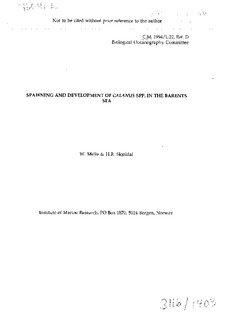Spawning and development of Calanus spp. in the Barents Sea
Working paper
Permanent lenke
http://hdl.handle.net/11250/105334Utgivelsesdato
1994Metadata
Vis full innførselSamlinger
Originalversjon
This report is not to be cited without prior reference to the authorsSammendrag
From 1986 to 1988 eight cruises were conducted in the Barents Sea, covering
Atlantic water in central parts of the Sea and meltwater and Arctic water in
the Polar front region. During the cruises hydrography, nutrients,
phytoplankton biomass and abundances of life stages of the three Calanus
species; C. finmarchicus, C. glacialis and C. hyperboreus, were mapped. From
this, development and spawning of the copepods in different water masses
were related to the timing and progress of the phytoplankton spring bloom.
In central parts of the Atlantic water stabilization was caused by formation of
a thermocline due to atmospheric warming and the process was time
dependent. Phytoplankton spring bloom development was closely related to
water column stability. Rates of egg production of the female populations of
C. finmarchicus and C. glacialis showed strong correlations with chlorophyll
content, indicating a functional relationship between spawning and food
supply.
In the meltwater region water column stabilization was caused by ice melting,
which is not purely a time dependent process. However, also in this region a
close relationship between phytoplankton spring bloom development and
spawning of C. glacialis was found. Spawning of C. finmarchicus was out of
phase with the spring bloom and peaked during the post-bloom period. This
was explained by a retarded development of the overwintered stock of C.
finmarchicus in the meltwater region. In Arctic water development seemed
to be slower for both species. Thus, mis-match between the phytoplankton
bloom and spawning of C. finmarchicus due to retarded development is
suggested as the main factor making this species an expatriate of the northern
Barents Sea. In C. glacialis a two-year life cycle in the warmer parts of the
Barents Sea, may result in a too long life span relative to the mortality rate of
this area, and the species may be expatriated in the southern Barents Sea.
C. hyperboreus was found to spawn in January and February, or earlier, well
before the spring bloom. The nauplii, however, did not develop beyond stage
NIII which is the first feeding stage until the food concentrations increased
during the spring bloom.
